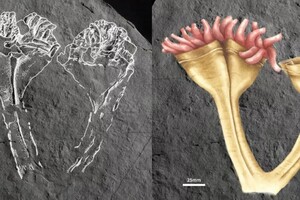The age of the fossil is estimated at 560 million years.

A bizarre creature with tentacles that lived in the oceans Earth 560 million years ago and resembled modern sponges, was probably the first predator from the animal kingdom. This is the conclusion reached by scientists who conducted a re-analysis of fossils discovered more than 10 years ago, reports Live science.
The remains of the creature were found in an outcrop of volcanic and sedimentary rocks called the Bradgate Formation in Leicestershire, England. The rocks were formed approximately 557 – 562 million years ago during the Ediacaran period. That is, fossils appeared even before the Cambrian explosion, an episode when life on Earth rapidly diversified.
Read also: Paleontologists found a dinosaur egg inside another egg
According to scientists, Precambrian Fossils rarely resemble forms similar to modern animals, so the discovery of an Ediacaran jellyfish-like animal is something incredible.
Philip Donohue, a paleobiologist at the University of Bristol in England, said that most of the Ediacaran animals currently known do not share structural features with extant creatures. Therefore, they are considered to belong to extinct groups of animals. The scientist noted that this fossil may be the oldest known creature belonging to the existing species.
The creature was named Auroralumina attenboroughii. Its generic name means “lantern of the dawn” and indicates its bizarre shape, as well as the age of the fossil. The species name is given in honor of the TV presenter and biologist Sir David Attenborough for “his work to raise awareness of the Ediacaran fossils in Charnwood Forest”.
A team of researchers discovered the A. attenboroughii fossil during an expedition in 2007 year in Charnwood Forest, but the first important finds were made here back in the 1950s. Then two children, first Tina Negus and then Roger Mason, found a fern-shaped fossil in the quarry. This organism, named Charnia masoni, was the first fossil that could be confidently dated to the Ediacaran period.
During the 2007 expedition, scientists studied a rock that rose above the forest floor at an angle of 45 degrees. When scientists scraped a layer of soil from the surface of the rock, they discovered that it contained thousands of fossils belonging to 20-30 different species. With the exception of A. attenboroughii, they resembled already known branchial creatures that existed in the Ediacaran period.
The researchers created casts of the rock, and then built 3D models of the ancient creatures on their basis. As a result, they found that one creature resembled a candelabra with two cup-like structures moving away from each other. And short tentacles protruded from the edges of each “cup”. Ribs running on both sides of the fossil indicated that these cups were supported by a rigid skeleton.
A. attenboroughii shares many basic characteristics with Cambrian fossil Medusozoa, the group that includes modern jellyfish. Even though the description of the creature doesn't look like a jellyfish, that doesn't mean they don't have any similarities at all. At a certain stage in their life, jellyfish attach themselves to the seabed to reproduce asexually. And at this time they resemble A. attenboroughii.
If A. attenboroughii is indeed a member of the Medusozoa, it must belong to a broader group of organisms known as cnidaria, which also includes corals, sea feathers, and sea anemones. It was previously thought that this group could not have originated before the Cambrian period, but new evidence indicates that it appeared 20 million years earlier than previously thought.




